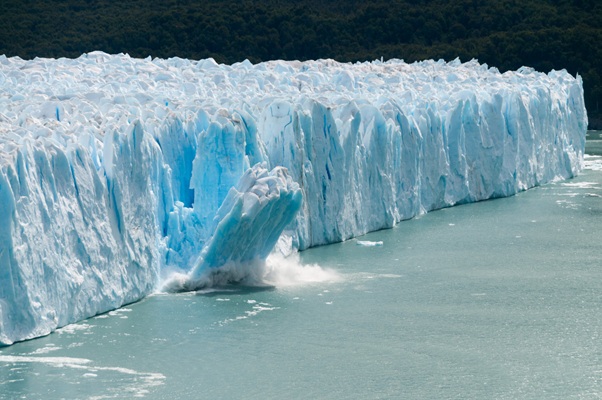.png)

Michael Patra is an economist, a career central banker, and a former RBI Deputy Governor who led monetary policy and helped shape India’s inflation targeting framework.
October 1, 2025 at 12:51 AM IST
It is said that where a glacier meets the sky, the earth becomes one with the heavens. No sorrows live there, and therefore joy is not necessary.
Beauty alone reigns.
According to the American writer, humorist and essayist Mark Twain, pen name of Samuel Longhorne Clemens, “a man who keeps company with glaciers comes to feel tolerably insignificant by and by.” These slow-moving rivers of ice have sculpted mountains and carved valleys throughout the Earth's history. They continue to flow and shape the landscape even today. Glacier melt delivers nutrients into lakes, rivers, and oceans, which can drive blooms of phytoplankton—the base of aquatic and marine food chains. Glacier melt also sustains stream habitats for plants and animals. In some regions, glaciers provide life-sustaining water for people as well as wildlife. The Tibetan Plateau alone is the source of 10 of Asia’s biggest rivers and provides water to 20% of the world’s population. Many of the rivers coursing through China, India, and other parts of the Asian continent are fed largely by snowmelt from the Himalayas, but in late summer, a significant part of river flow comes from melting glaciers. In South America, residents of La Paz, Bolivia – the highest capital in the world - rely on glacial melt to provide water. In Switzerland's Rhone Valley, farmers have irrigated their crops for hundreds of years by channelling meltwater from glaciers to their fields. Glaciers also help generate hydroelectric power in Norway, Central Europe, Canada, New Zealand, and South America.
Tragically, glaciers are becoming the casualty of climate change, its visual language. In fact, one of the most prominent signs of ongoing climatic change is that the vast majority of glaciers are shrinking worldwide at unusually high rates in the past century. Some have disappeared altogether. Glaciers around the world are under siege. The world’s glaciers are melting at a rate equivalent to three Olympic swimming pools of water every second. Ancient glaciers are under threat across the globe, from the Himalayas to the Andes, but the melting process has been most apparent in Europe, with Europe’s Alps and Pyrenees the worst affected.
The consequences for humanity are ominous. In February this year, a glacier burst near Badrinath in Uttarakhand’s Chamoli district, triggering an avalanche that buried 57 construction workers under snow. This mountain state has been witnessing glacier bursts with disturbing frequency and rising intensity. A deadly flood sparked by a cratering glacier breaking away and falling into the valley last year left over 140 dead. At least 80 people were killed and more than 200 were reported missing when a part of the Nanda Devi glacier broke away in February 2021. An avalanche in 2022 killed 16 people. The Uttarakhand flash flood on August 5, 2025, killed at least ninety people and left more than 50 others missing. The cause of the event is still being investigated. Media initially reported a cloudburst as the trigger, but scientists are now exploring the possibility that a combination of a glacial lake outburst flood (GLOF), a glacier collapse, and a landslide may have caused the Kheer Ganga river to overflow with immense force.
These are not isolated incidents but the result of a rapidly warming planet. In fact, all Himalayan glaciers are experiencing accelerated melting due to rising temperatures, leading to the formation of glacial lakes. According to ISRO, more than 27% of the Himalayan glacial lakes that have been identified have significantly expanded since 1984, with 130 of those lakes being in India. Satellite images reveal that the expansion of these lakes is occurring at an alarming rate and increasing the risk of GLOFs. In fact, GLOF events have become increasingly common in Nepal. On July 8, floodwaters tore through Rasuwa district, sweeping away a critical border highway and took its toll on lives - killed and missing. Scientists have determined that the cause was an outburst from a glacial lake.
According to scientists, even if warming temperatures could suddenly be halted, it would already be too late for hundreds of Switzerland’s 1,400 glaciers, which make up about half of all the glacial ice in the Alps. Last year, Venezuela became one of the first countries in modern history to lose all of its glaciers. Climate models suggest that Germany’s glaciers will disappear within a few years. Up to 80% of glacier mass is expected to be lost by the end of the century, depending on efforts to cut greenhouse gas emissions and reduce the global temperature rise. Not surprisingly, therefore, the United Nations has designated 2025 as the International Year of Glaciers' Preservation. The world must act before it is too late.
Nepal marked the rapid melting of the Yala glacier, one of the most studied and measured ice bodies in the Hindu Kush Himalaya region, with a “funeral.” Two memorial plaques carved in Nepali granite were installed at the base of the dying Yala. Monks, scientists, government officials and community figures took part in the ceremony. Glacier funerals have been held in Iceland, Mexico, and Switzerland in recent years.
Without diminishing the hazards glaciers pose to people living downstream, one of the most serious consequences of melting glaciers is rising sea levels. According to the Intergovernmental Panel on Climate Change, global sea level has risen since the early 1970s because of a combination of ocean thermal expansion and glacier mass loss. In contrast to the polar regions, lower latitude small glaciers and ice, although making up only about four percent of the total land ice area, may have provided as much as 60% of the total glacier-driven sea level rise.
The threat to sea levels triggers an ancient spasm in my DNA. During the time of Shri Chaitanya (1486-1534), five great men (mahapurush), his disciples, so profoundly influenced contemporary spirituality and literature that a panchsakha tradition emerged. It transformed religious scriptures into simple prose so that the layperson could understand spiritual concepts and benefit from them. Legend has it that the panchsakha take birth at the end of each cyclical epoch or yug to contribute to the establishment of dharma. There have been four yugs so far, i.e., satya yug, treta yug, dwapara yug and kali yug, with each yug’s length and humanity's general moral and physical state decreasing by one-fourth; kali yug, which lasts for 432,000 years, is believed to have started in 3102 BC. In kali yug, the panchasakha authored various books, with the Bhavishya Malika being among the most prominent, written ahead of the arrival of the tenth and final avatar of Vishnu - Kalki.
According to the Bhavishya Malika, several signs will appear in Puri, Odisha, warning about the imminent ending of the kali yug. It is believed that several of these signs have occurred already. The prophecies of the Bhavishya Malika foretell of the melting of glaciers and Arctic ice, resulting in a significant rise in sea levels and submerging several powerful nations. The waters of the sea will inundate the 22 steps of the Jagannath Temple and fish will swim on those steps. Within the next two to three years, unprecedented catastrophes will mark the end of the kali yug.
Hence I mourn the dying of glaciers – perhaps they forewarn of a greater annihilation.
Let us save what remains.
While we can.




